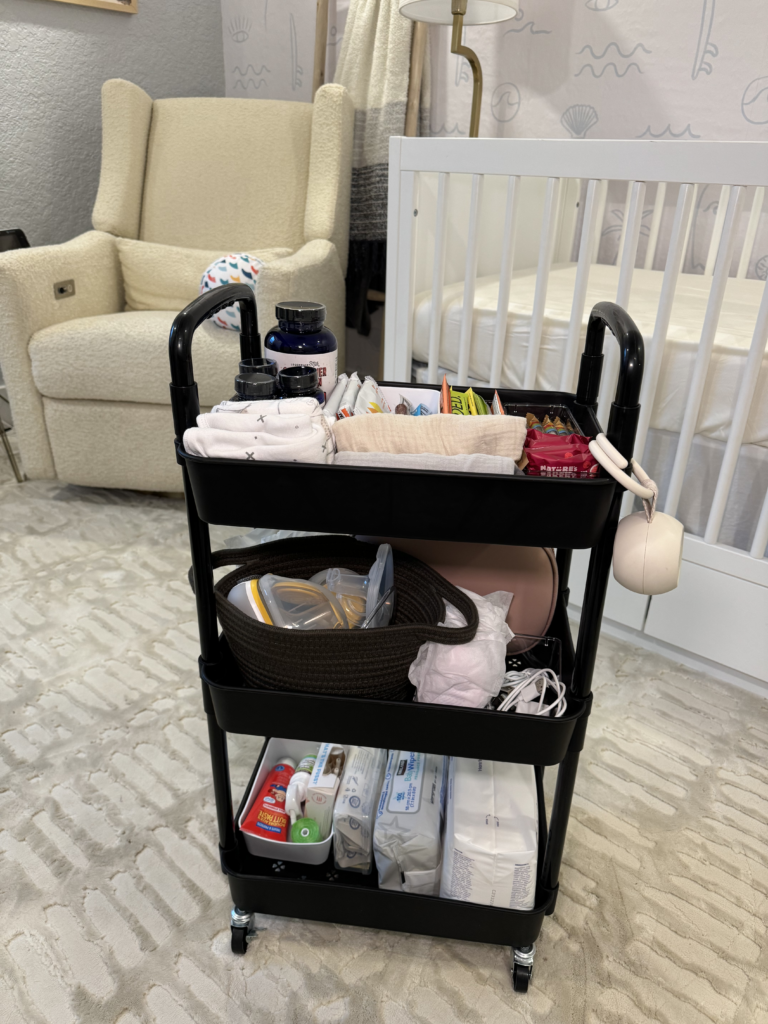How to Get Your Newborn to Sleep in Their Bassinet

Getting your baby to sleep in their bassinet can feel impossible. But, there are so many things to take into consideration and proven methods to get your newborn to sleep in their bassinet that actually work. Below we will cover the most effective methods to get your newborn to sleep in their bassinet and end your sleepless nights.
Reasons your newborn wont sleep in their bassinet
Newborn babies need to learn how to fall asleep on their own. The first thing you want to do is eliminate any factors that might make it difficult or impossible to get your newborn to sleep in their bassinet. You want this process to be as smooth as possible for you and your newborn to get good sleep. In order to do that, it is important to understand all of the factors when it comes to sleep. As a new mom/parent or second time mom/parent, there is always more to learn when it comes to your baby and getting them to sleep in their bassinet.
Your baby is overtired
The most common reason you can’t get your baby to sleep is because they are overtired. An overtired baby will make it so much harder for them to go to sleep and will cause lots of irritation and crying. A newborn’s wake windows are typically 30-60 minutes, but it can vary from baby to baby. At 2 months old, your baby will start having longer wake windows from 60-90 minutes.
Look up your babie’s wake window to find out how long they should be awake in between naps. It is important to notice your newborn’s sleep cues to make sure they are not getting overtired. An overtired baby is much more fussy and does not go to sleep easily.
Anxious Parents
Another reason you can’t get your baby to sleep is because of you! Anxious parents who are hovering around wake their babies up. Most of the time when your baby is trying to go to sleep or about to sleep, they will rustle and make noises. Sometimes, they even let out a little cry. If you are rushing over to check on them with every sound they make, you are likely waking them up.
To avoid this, try sitting in a rocking chair or on the other side of the room from the bassinet. Put a headphone in and watch a video on your phone to distract yourself. Obviously, if your baby is crying, you should soothe them. But if they are fussing for a minute, don’t rush over to wake them up. Distracting yourself as a parent will help the overall atmosphere and promote healthy sleep habits for your little one.
Sleep Association
Babies who need to be held or fed to fall asleep have “sleep association” which doesn’t allow them to naturally soothe themselves and fall asleep on their own. Creating good sleep habits will be difficult at first, but will help your baby sleep so much better in the long run.
Breaking their sleep association is like breaking any habit. But if you can stick with it, it will be worth it. If your baby needs to be held to fall asleep, you should try to make sure they are fed and lay them down drowsy but awake. They will eventually learn to self-soothe. But you need to make sure all their needs are met before laying them down. The best method is to wake, feed, play, and sleep. This will break them of needing to be fed to fall asleep and ensure they have played enough to get their energy out.
Startle Reflex
The startle reflex, also known as the moro reflex, is a reflex that every baby develops. It is a protective response to loud noises or sudden movements that cause babies arms or legs to sprawl out, push them back into their chest or body and the baby will start crying. This normally goes away after 3-6 months.
To help avoid this from keeping your baby awake, having a noise machine in the background is helpful. A silent environment creates bad sleep habits because they will learn to not be able to sleep with any noise which can make sleeping very difficult. Investing in a quality white noise machine is essential for good sleep.
5 Tips to get your baby to sleep in their bassinet:
Set up the room. Turn off the lights, turn on the sound machine, try blackout curtains, and ensure the crib is empty and sheets are soft. Creating a safe sleep environment is extremely important for your baby's sleep and safety. For safe sleep guidelines, you should refer to the National Institute of Health and American Academy of Pediatrics for best practices. In the first few months, the risk of SIDS is significantly higher which is why you want to ensure they are only sleeping on a flat mattress without blankets or any other clothing that could get in the way of their face. Once a baby is 6 months, they can be transitioned into their own room.
Make sure babies' needs are met. Ensure they are fed, play enough that they are tired but not overtired, change their diaper and lay them down drowsy but awake. Give them full feedings that leave them satisfied so you can be sure they are not hungry.
Once they are laid down, first try to see if they can fall asleep on their own. If they are crying and cannot soothe themselves, try to make a “shhhh” sound to soothe them. If that is not working, try soothing them by patting them gently. If they still cannot sleep, try rocking them. And lastly, if none of the above is working, you can feed them or hold them to sleep and try again another time.
If you find they keep waking themselves up, try swaddling them. It is best to try to get babies to sleep on their own without support, but if they need it, it is better for them to use it and get sleep than have poor sleep or no sleep. The same applies to soothing mechanisms like sucking on a pacifier.
The best time for putting your baby to sleep in their bassinet is the first nap of the day. As the parent, you will be awake and able to help them through the transition. For your baby, you can time this well from the time they wake up to ensure their wake window is long enough for a good stretch of sleep.
Newborn Sleep: Nap Time and Wake windows
Creating healthy sleep habits for your baby starts with consistent nap times and wake windows. A popular sleeping schedule is the “Moms On Call” schedule. Many parents have found this to work very well for their baby. I found this helpful with both of my kids because they also have an app that helps following the schedule much easier.
Most new parents are told to never wake a sleeping baby. But babies will sleep longer than they should and wake up starving and screaming. In order to get your baby to sleep well at night, you need to have consistent nap times and wake windows.
Having a consistent bedtime routine will help your baby get longer stretches of sleep throughout the night. Giving your baby a bath, reading them a book, spending time with them can all be parts of a bedtime routine that promotes melatonin production and relaxation. What is most important is that the routine is consistent and your baby knows what to expect. This will help them understand that it is time for bed.
Sometimes you might need to adjust your baby's sleep schedule based on their nap times and wake windows. If you can’t get them to sleep for an hour, you will need to push back their nap routine by an hour. This means that at night when they go to bed, their bedtime will be an hour later.
Sleep Training Techniques
There are many well-loved sleep training techniques and methods.
Some of the best sleep training techniques are:
Many of these methods and courses are loved by many moms. These are ranked in the order of which ones are most popular. Having an aid like a course can make sleep training so much easier and give you the necessary information to be successful. Like many moms, I thought sleep training was evil and wrong. It wasn’t until I took a course that I realized it doesn’t have to mean you are letting your baby cry in their crib. There are so many important factors to consider and learn. In the long run, having your baby get good sleep is extremely important for their life and development. Not to mention how important it also is for you.
Middle of the night wakings
Those middle of the night wakings should be treated the same as daytime wakings. Your newborn baby will begin to get longer stretches of sleep as their stomach grows and they can be fuller longer. If you have a fussy baby, you can try to burp them for at least 5-10 minutes before putting them down.
For night feedings, you can try to dream feed your baby while they are asleep to keep them sleeping longer without waking them up. Since they are used to a schedule and a routine, giving them a full feeding will ensure their bellies are full and they can sleep longer.
What About Diaper Changes?
Before your baby goes to sleep, you always want to make sure that their diaper is changed. During the middle of the night feeds, check and see if your newborn needs a diaper change. If not, then don’t worry. If they do feel full, it is important to change their diaper so they sleep longer and don’t get a diaper rash. The best way to do this without waking them up is to keep the lights low. Also, try a wipe warmer as well.
What do I do during a sleep regression?
Babies have sleep regressions during certain growth periods. During this time, you might notice all the sleeping habits you worked so hard to build, seem to have gone out the window. Don’t worry, your baby is probably going through a sleep regression. The best thing to do is change nothing. You know from doing it, that it works. Changing things and looking for other answers will only derail your progress.
Know that it is a phase and it will go back to normal when the sleep regression is over. If you try to change things and make a new sleep schedule or routine, your baby is going to get out of their patterned routine and not know what is going on. This is going to make it harder for them to soothe themselves to sleep. The last thing you want is to give up and end up soothing them to sleep yourself. During a sleep regression, the best thing to do is stay consistent with what you are doing and give your baby some extra love.
How many hours of sleep should my newborn get?
Your newborn should get 14-20 hours of total sleep time a day. Most babies get 14-17 hours while some get 18-20 hours of sleep. Your baby will alternate between active and quiet sleep, but it all counts towards the total hours of sleep. The amount of time your baby will sleep during the night should be taken into consideration based on how much they are sleeping during the day. Keeping them on a consistent schedule, you can map out how long they are sleeping during the day to help them get better sleep at night.
Getting Your Newborn to Sleep in Their Bassinet
With all of this information in use, getting your newborn to sleep in their bassinet should be easy. There is a wealth of information and knowledge in sleep training courses that dive deeper into the specifics of sleep training. But, you should try everything in this article as a first step to getting longer stretches of sleep for you and your baby. Implementing every step will ensure your baby will learn to self-soothe and get great sleep at night. This is everything you need to know about getting your newborn to sleep in their bassinet.



